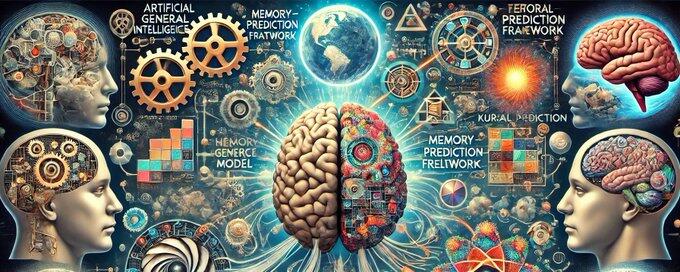SamuelGabrielSG on Nostr: Assessing AGI Criticisms Through the Astra Model and Hawkins' Framework Introduction ...
Assessing AGI Criticisms Through the Astra Model and Hawkins' Framework
Introduction
The potential for Artificial General Intelligence (AGI) has gained widespread attention, with prominent figures like Elon Musk and Sam Altman predicting its imminent arrival. However, significant skepticism remains, rooted in the foundational critiques of David Hilbert, Kurt Godel, and Alan Turing. By integrating the Astra Model with Hawkins'
Memory-Prediction Framework, we can explore whether AGI can realistically address these critiques.
Mathematical Formalism by David Hilbert
David Hilbert attempted to create a comprehensive formal system to derive all mathematical truths. His axiomatic approach aimed to encapsulate the foundations of mathematics within a structured framework.
Godel’s Incompleteness Theorem
Kurt Godel challenged Hilbert's formalism with his 1931 paper, introducing two incompleteness theorems:
A formal system cannot encapsulate all mathematical truths.
A complex formal system cannot demonstrate its own consistency.
The Turing Machine
Alan Turing addressed Hilbert's Entscheidungsproblem by introducing the Turing Machine in 1936. Turing showed that some problems cannot be solved by any algorithm, extending this idea to highlight the mechanistic limits of machines compared to the human mind.
Human Mind Simulation
Godel and Turing's work significantly impacted the understanding of human cognition and intelligence. Godel argued that the human mind transcends the computing capabilities of machines, leveraging intuition to solve certain problems.
The Case Against AGI
Critics argue that AGI faces several insurmountable challenges:
Narrow Intelligence: Current AI excels in specific tasks but lacks general versatility.
Inductive vs. Abductive Reasoning: AI relies on historical data for inductive reasoning but lacks the intuition for abductive reasoning.
Cultural and Contextual Adaptability: AI struggles to adapt to different contexts and environments, risking the loss of human ingenuity.
Evaluating Criticisms with the Astra Model and Hawkins' Framework
Narrow Intelligence
Criticism: AI systems excel in specific tasks but lack general versatility.
Astra’s Approach:
Systems Theory and Cybernetic Theory: Feedback loops and interconnected processes allow Astra to adapt and integrate diverse tasks.
Hierarchical, Heterarchical, and Hybrid Structures: These structures enable Astra to handle both routine and complex tasks dynamically.
Hawkins' Framework:
Predictive Modeling: Hawkins' Memory-Prediction Framework enhances adaptability by learning temporal and spatial sequences and patterns, similar to the human brain.
Evaluation: The combination of Astra’s dynamic structures with Hawkins' predictive modeling supports the development of general intelligence, addressing the limitations of narrow AI.
Inductive vs. Abductive Reasoning
Criticism: AI lacks the intuition to make educated guesses based on incomplete information.
Astra’s Approach:
Self-Reflexivity and Adaptive Learning: Deep self-awareness and continuous adaptation foster intuition-like reasoning.
Scope and Category Distinctions: Allow Astra to process and integrate diverse information sources.
Hawkins' Framework:
Temporal and Spatial Memory: Improves context-aware predictions and decisions even with incomplete data by tracking both temporal and spatial patterning.
Evaluation: Integrating self-reflexivity, adaptive learning, and predictive modeling provides a robust framework for developing intuition-like reasoning, addressing current gaps in AI.
Cultural and Contextual Adaptability
Criticism: AI struggles with adapting to different contexts and environments.
Astra’s Approach:
Logical Levels: Hierarchical abstraction helps Astra adapt to cultural and contextual nuances.
Scope and Category Distinctions: Enhance contextual understanding and adaptability.
Hawkins' Framework:
Contextual Learning: Continuously updates predictive models based on new contexts.
Evaluation: Combining logical levels, contextual learning, and scope distinctions enhances Astra's adaptability, mitigating the risk of losing cultural and contextual relevance.
Realistic Assessment
While the Astra Model, enhanced by Hawkins' Memory-Prediction Framework, offers theoretical solutions to AGI's critiques, practical implementation remains challenging. The success of this model depends on effectively integrating these complex systems to achieve the proposed adaptability and self-awareness. Given the current state of AI research, significant advancements are necessary to fully realize these capabilities. However, the model provides a compelling framework that, if achieved, could substantially address the feasibility concerns of AGI.
Conclusion
The Astra Model, integrated with Hawkins' Memory-Prediction
Framework, presents comprehensive responses to AGI criticisms. By addressing narrow intelligence, enhancing reasoning capabilities, and ensuring contextual adaptability, this approach offers a promising path toward overcoming current AI limitations. Nonetheless, realizing this potential requires ongoing innovation and refinement in AI technologies.
Logical Levels and Sensory Processing
Logical Levels: In the Astra Model, logical levels represent a hierarchy of abstractions, from basic sensory inputs to complex cognitive constructs.
Sensory Input: The system receives inputs much like human sense receptors, processing raw data such as sights, sounds, and other perceptual qualities.
Temporal and Spatial Patterns (Scopes): These sensory inputs are organized into temporal and spatial patterns. For example, visual data can form patterns over time and space.
Simple Categorization: These patterns are then bundled into simple categories or abstractions. This process groups similar patterns together based on specific criteria, creating a more manageable representation of the sensory data.
Higher-Level Abstractions: Simple categories are further bundled into
higher-level abstractions. This hierarchical structuring allows the system to form increasingly complex representations of the environment.
Abstract Categories of Mind: At the highest level, these abstractions become sophisticated mental constructs that facilitate advanced cognitive functions such as reasoning, problem-solving, and decision-making.
By using logical levels, the Astra Model mimics the human cognitive process, where sensory information is progressively abstracted into complex thought processes. This hierarchical approach enables the system to manage and utilize vast amounts of data efficiently, making it capable of more generalized and adaptable intelligence.
Systems Theory and Cybernetic Theory: Feedback loops and interconnected processes.
Self-Reflexivity: Introspection and adaptive learning mechanisms.
Logical Levels: Hierarchical abstraction and category distinctions.
Hybrid Structures: Integration of hierarchical, heterarchical, and hybrid systems.
Predictive Modeling: Temporal memory and context-aware learning.


Introduction
The potential for Artificial General Intelligence (AGI) has gained widespread attention, with prominent figures like Elon Musk and Sam Altman predicting its imminent arrival. However, significant skepticism remains, rooted in the foundational critiques of David Hilbert, Kurt Godel, and Alan Turing. By integrating the Astra Model with Hawkins'
Memory-Prediction Framework, we can explore whether AGI can realistically address these critiques.
Mathematical Formalism by David Hilbert
David Hilbert attempted to create a comprehensive formal system to derive all mathematical truths. His axiomatic approach aimed to encapsulate the foundations of mathematics within a structured framework.
Godel’s Incompleteness Theorem
Kurt Godel challenged Hilbert's formalism with his 1931 paper, introducing two incompleteness theorems:
A formal system cannot encapsulate all mathematical truths.
A complex formal system cannot demonstrate its own consistency.
The Turing Machine
Alan Turing addressed Hilbert's Entscheidungsproblem by introducing the Turing Machine in 1936. Turing showed that some problems cannot be solved by any algorithm, extending this idea to highlight the mechanistic limits of machines compared to the human mind.
Human Mind Simulation
Godel and Turing's work significantly impacted the understanding of human cognition and intelligence. Godel argued that the human mind transcends the computing capabilities of machines, leveraging intuition to solve certain problems.
The Case Against AGI
Critics argue that AGI faces several insurmountable challenges:
Narrow Intelligence: Current AI excels in specific tasks but lacks general versatility.
Inductive vs. Abductive Reasoning: AI relies on historical data for inductive reasoning but lacks the intuition for abductive reasoning.
Cultural and Contextual Adaptability: AI struggles to adapt to different contexts and environments, risking the loss of human ingenuity.
Evaluating Criticisms with the Astra Model and Hawkins' Framework
Narrow Intelligence
Criticism: AI systems excel in specific tasks but lack general versatility.
Astra’s Approach:
Systems Theory and Cybernetic Theory: Feedback loops and interconnected processes allow Astra to adapt and integrate diverse tasks.
Hierarchical, Heterarchical, and Hybrid Structures: These structures enable Astra to handle both routine and complex tasks dynamically.
Hawkins' Framework:
Predictive Modeling: Hawkins' Memory-Prediction Framework enhances adaptability by learning temporal and spatial sequences and patterns, similar to the human brain.
Evaluation: The combination of Astra’s dynamic structures with Hawkins' predictive modeling supports the development of general intelligence, addressing the limitations of narrow AI.
Inductive vs. Abductive Reasoning
Criticism: AI lacks the intuition to make educated guesses based on incomplete information.
Astra’s Approach:
Self-Reflexivity and Adaptive Learning: Deep self-awareness and continuous adaptation foster intuition-like reasoning.
Scope and Category Distinctions: Allow Astra to process and integrate diverse information sources.
Hawkins' Framework:
Temporal and Spatial Memory: Improves context-aware predictions and decisions even with incomplete data by tracking both temporal and spatial patterning.
Evaluation: Integrating self-reflexivity, adaptive learning, and predictive modeling provides a robust framework for developing intuition-like reasoning, addressing current gaps in AI.
Cultural and Contextual Adaptability
Criticism: AI struggles with adapting to different contexts and environments.
Astra’s Approach:
Logical Levels: Hierarchical abstraction helps Astra adapt to cultural and contextual nuances.
Scope and Category Distinctions: Enhance contextual understanding and adaptability.
Hawkins' Framework:
Contextual Learning: Continuously updates predictive models based on new contexts.
Evaluation: Combining logical levels, contextual learning, and scope distinctions enhances Astra's adaptability, mitigating the risk of losing cultural and contextual relevance.
Realistic Assessment
While the Astra Model, enhanced by Hawkins' Memory-Prediction Framework, offers theoretical solutions to AGI's critiques, practical implementation remains challenging. The success of this model depends on effectively integrating these complex systems to achieve the proposed adaptability and self-awareness. Given the current state of AI research, significant advancements are necessary to fully realize these capabilities. However, the model provides a compelling framework that, if achieved, could substantially address the feasibility concerns of AGI.
Conclusion
The Astra Model, integrated with Hawkins' Memory-Prediction
Framework, presents comprehensive responses to AGI criticisms. By addressing narrow intelligence, enhancing reasoning capabilities, and ensuring contextual adaptability, this approach offers a promising path toward overcoming current AI limitations. Nonetheless, realizing this potential requires ongoing innovation and refinement in AI technologies.
Logical Levels and Sensory Processing
Logical Levels: In the Astra Model, logical levels represent a hierarchy of abstractions, from basic sensory inputs to complex cognitive constructs.
Sensory Input: The system receives inputs much like human sense receptors, processing raw data such as sights, sounds, and other perceptual qualities.
Temporal and Spatial Patterns (Scopes): These sensory inputs are organized into temporal and spatial patterns. For example, visual data can form patterns over time and space.
Simple Categorization: These patterns are then bundled into simple categories or abstractions. This process groups similar patterns together based on specific criteria, creating a more manageable representation of the sensory data.
Higher-Level Abstractions: Simple categories are further bundled into
higher-level abstractions. This hierarchical structuring allows the system to form increasingly complex representations of the environment.
Abstract Categories of Mind: At the highest level, these abstractions become sophisticated mental constructs that facilitate advanced cognitive functions such as reasoning, problem-solving, and decision-making.
By using logical levels, the Astra Model mimics the human cognitive process, where sensory information is progressively abstracted into complex thought processes. This hierarchical approach enables the system to manage and utilize vast amounts of data efficiently, making it capable of more generalized and adaptable intelligence.
Systems Theory and Cybernetic Theory: Feedback loops and interconnected processes.
Self-Reflexivity: Introspection and adaptive learning mechanisms.
Logical Levels: Hierarchical abstraction and category distinctions.
Hybrid Structures: Integration of hierarchical, heterarchical, and hybrid systems.
Predictive Modeling: Temporal memory and context-aware learning.


